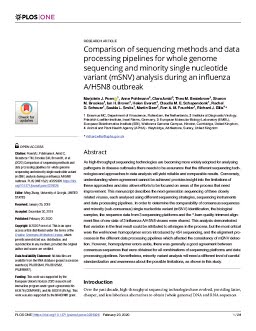2020-02-20
Comparison of sequencing methods and data processing pipelines for whole genome sequencing and minority single nucleotide variant (mSNV) analysis during an influenza A/H5N8 outbreak
Publication
Publication
PLoS ONE , Volume 15 - Issue 2
As high-throughput sequencing technologies are becoming more widely adopted for analysing pathogens in disease outbreaks there needs to be assurance that the different sequencing technologies and approaches to data analysis will yield reliable and comparable results. Conversely, understanding where agreement cannot be achieved provides insight into the limitations of these approaches and also allows efforts to be focused on areas of the process that need improvement. This manuscript describes the next-generation sequencing of three closely related viruses, each analysed using different sequencing strategies, sequencing instruments and data processing pipelines. In order to determine the comparability of consensus sequences and minority (sub-consensus) single nucleotide variant (mSNV) identification, the biological samples, the sequence data from 3 sequencing platforms and the *.bam quality-trimmed alignment files of raw data of 3 influenza A/H5N8 viruses were shared. This analysis demonstrated that variation in the final result could be attributed to all stages in the process, but the most critical were the well-known homopolymer errors introduced by 454 sequencing, and the alignment processes in the different data processing pipelines which affected the consistency of mSNV detection. However, homopolymer errors aside, there was generally a good agreement between consensus sequences that were obtained for all combinations of sequencing platforms and data processing pipelines. Nevertheless, minority variant analysis will need a different level of careful standardization and awareness about the possible limitations, as shown in this study.
| Additional Metadata | |
|---|---|
| doi.org/10.1371/journal.pone.0229326, hdl.handle.net/1765/125109 | |
| PLoS ONE | |
| Organisation | Erasmus MC: University Medical Center Rotterdam |
|
Poen, M., Pohlmann, A. (Anne), Amid, C. (Clara), Bestebroer, T., Brookes, S. M., Brown, I., … Ellis, R.J. (Richard J.). (2020). Comparison of sequencing methods and data processing pipelines for whole genome sequencing and minority single nucleotide variant (mSNV) analysis during an influenza A/H5N8 outbreak. PLoS ONE, 15(2). doi:10.1371/journal.pone.0229326 |
|

